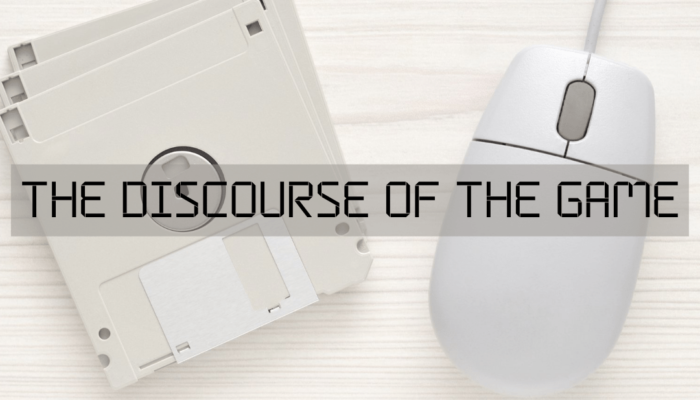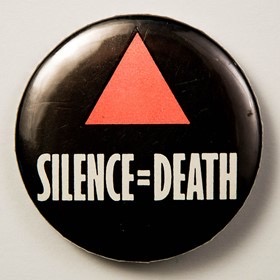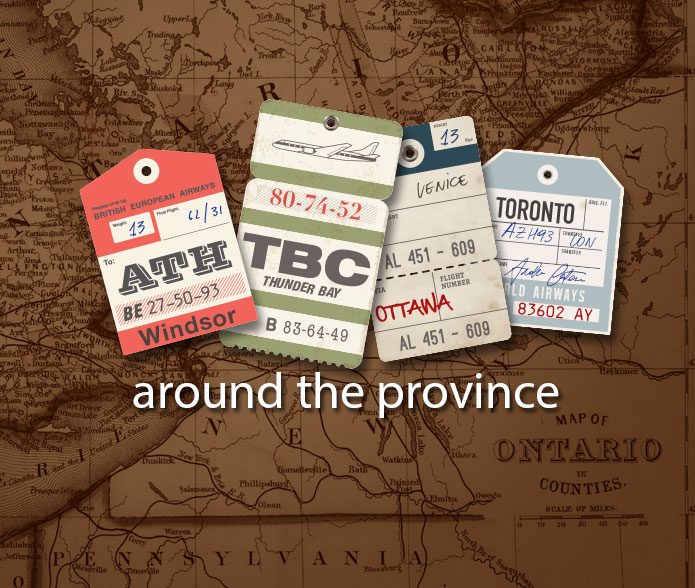Learn about a librarian’s research into 2SLGBTQ+ Libraries and Archives, preserving queer history, and current activism efforts.

The discourse of the game: An interview with Chris Young on UTML’s Syd Bolton collection
The Reading Room on the second floor of the University of Toronto Mississauga Library (UTML) is now becoming the entry point for the largest video game collection in Canada. The Syd Bolton Collection is an incredible new resource that is bound to make the Library a hot spot for curriculum development in Games Studies, student and faculty investigations into the history and discourse of the video game industry, and research by scholars in the surrounding community. But acquiring, cataloguing, maintaining and making accessible a collection of this size comes with its own special challenges for archiving and librarianship. In this interview, Chris Young (Head of UTML Collections and Digital Scholarship) details the successes, hurdles and future of the collection.
David Gerstle: Could give me a little bit of background on the timing of the acquisition?
Chris Young: A few years ago in 2018, Syd Bolton passed away unexpectedly, according to his friends and family. He was young—in his late 40s. He had been collecting games pretty much his whole life. He was also a PC enthusiast. When he was younger, he saw people tossing personal computers away. Back in the 80s, these computers were worth $10,000—which in today’s currency is something like $25,000. So, he started to also collect personal computers and games to play on those. I know we’re talking about the games collection but the second collection, which is arriving in a month, is the personal computer museum that he ran out of his house. The two are separate, in that the games collection is his personal collection, but the PC museum was kind of a charity that he ran for school visits and the general public. And he ran this in the equivalent of a coach house that was on his property in Brantford.
His widow didn’t want to keep the collection because it took a lot of space but also a lot of responsibility. He was very passionate about this collection, but there is also so much to think about in terms of upkeep. She was looking to sell it to an academic library or museum, one that would maintain it but also keep it in a position where people could access it. Syd, when he ran the PC museum, made these accessible for people to use. They wouldn’t be behind glass. You’d be able to go and interact with them.
They were unsuccessful in getting bids, or at least getting bids that were an appropriate for the value. With a game collection, there are the issues: how are we going to make it accessible? How are we going to preserve it? They are complex items. At the same time, there is a vastly growing area of Games Studies research. It’s one of the largest entertainment industries in the world. It’s increasingly a medium of choice for people to interact with, as well as to make games, expressively. It’s no longer a niche thing, it’s a very expressive medium. Librarians, curators, archivists, as caretakers of knowledge and information, I think we’re beholden to make it accessible in some capacity. Or at least try to.
Fast forward a bit to last year, in the summer months of the pandemic, a friend of mine who works in the game industry but also volunteers at an organization called the Hand Eye Society, reached out to me about someone wanting to sell this collection to a library or museum. He knew I was a librarian and wanted to know if this is something UTM would be interested in. I replied that of course I am interested in it, but the issue is whether this fits within the wider mandate of the library, and also whether it is going to be used by researchers and instructors here. I pitched it to Shelley [Hawrychuk, UTML Chief Librarian], she was keen on it. We talked with the executive administration of the campus. Previous to these discussions, there had already been talk about setting up a Games Studies minor, because there are an increasing number of courses that focus on the study of games or have games as a component in the curriculum. They were looking to solidify this as something that is unique at UTM. Unique from the other campuses and unique in the Ontario region.
So we put in a bid, and ours was the most successful. The person who was organizing it was also keen for us to obtain it because some of the other bidders already had substantial collections. So even though it is enormous, it would not be a unique collection, it would just enhance pre-existing ones. For us, this would be a centerpiece collection that we build on and enhance and develop further. We transferred it to UTM Library in early October 2020.
DG: So, for the nitty-gritty of what the collection contains, what are the numbers that you can give me?
CY: We have either just shy of, or just over, 14,000 video games. These are discs or cartridges, things that would have worked on the home consoles. And that goes from the late 70s to the present. There are some of those home video game consoles –
DG: Like Pong?
CY: Yes, they’re precursors to the insertable cartridge. Systems that have 4 or 5 games built into them. Otherwise, there are the iconic systems that people are familiar with, like the Atari 2600, 5600, and 7200; the Nintendo Entertainment System. We have the Sega Master System. And then, beyond that, probably every system that people can remember: Genesis; Saturn; Dreamcast; Playstation I, II, III, and IV; Xbox and Xbox 360; the Nintendo NES and the Super NES; the N64; GameCube; the Wii. Pretty much anything that was being made up until 2018 is in this collection.
Alongside all those well-known systems are a number of less well-known systems that people of the period will remember, but have been forgotten because they weren’t successful. Everyone knows the Sony PlayStation, but when it came out, some of the other television companies released their own consoles as well. We have the Panasonic 3do and the Philips cdi, which were the competitors at the time. There’s a Russian version of a GameBoy. There are a number of children’s consoles which were released in the late 90s. There are also the hand-helds: the GameBoy, the PlayStation Portable. And then lots of portables: controllers, cords, all the hardware that goes with it.
There’s also this ridiculous console… I don’t know what Xbox was thinking! They built a kind of cockpit that you set up on a table, with foot pedals and steering. I’m not making this up. It caught the eye of Nathan [Wolfe, Reference and Research Specialist], and he remembered when this came out. It’s built just for one game. So maybe we’ll set it up for the holiday party, if that happens.
And then in addition to all the games and the hardware, there are the magazines, books, and print material. Almost all of the games have the packaging and manuals, because [Bolton] made sure he bought copies that had everything. If he only found a cartridge, he would pursue a complete copy of it. So that is where the real value of this collection lies. Many games today, the menu systems are all set inside the game itself. If you need to look at a tutorial, you can go to YouTube. But 30 or 40 years ago, the internet didn’t exist. The disks and cartridges were limited in how much memory they could store, so developers weren’t going to waste that to put instructions. But it was easy to print that out and slot it into the package.
So how we interact with games is very different from how it once was. That makes this collection extremely valuable. All of those things that people discarded are in there.
I would say we have 150 magazine titles where we have a significant number of issues, and that covers game history and personal computer history. These are magazines like Nintendo Power, with about 300 issues made. We have about 250. Depending on the magazine, we could have several hundred issues, or we could just have 20 or 30. We don’t have every magazine, for example Edge, which still prints to this day. We will work to add that, seeing if someone is selling a complete run. It’s an area that we want to fill.
In game studies, if people want to do a macro analysis of the industry, it’s really hard to do with just the games. You need to look at game reviews, developer interviews, the discourse around the game, how it’s marketed and imaged. Some of the early game studies were doing gender analysis of the representation of women in games, and they would look at all the runs of these magazines, and do analysis of the covers or the imagery, how they were discussed in articles about, for example, Tomb Raider. Having that, in addition to the game, is really valuable for researchers. Someone could pull out a game, go to the corresponding year and months that came out and see if there’s any coverage on it. If there is, they use that to supplement the game. Right now there’s no vendor that has a digitized collection of these magazines. The opportunity of going back and looking at the serials from the 70s, 80s, or 90s doesn’t exist. Electronic magazines have really only existed for the last 10 years.
DG: I had students at a previous university who were interested in gender representation in games. Can you think of any other possible research projects that you’re trying to plan for?
For current projects, we have some Research Opportunities Program (ROP) students working with a professor doing game history research. The students have said they’re going to focus on Nintendo and the NES games. They’re going to make for us a couple of digital exhibits. It’s neat to involve researchers – student researchers – who can do something, learn something, get credit, and also have something published on the website.
There’s a course, Games and Medieval History, looking at the representation of the Middle Ages, such as depictions of the Crusades. This instructor found out about the collection at the beginning of the month, so we’ll be doing a teaching tour. If that course is offered again next year, some of these materials might be embedded into the curriculum, and the same with other courses that are being developed.
This is a teaching collection. We’re not a research library, and anything we buy is intended to be used for teaching. This is a special collection, but it’s intended to be used by courses at UTM. It’s for the students. An added bonus is that it can also be seen as a research collection. Our hope is that over time we’ll be able to integrate it more into the wider gaming studies research culture. And that would mean we could get funding for fellowships so that researchers could visit.
Right now though, it’s just arrived. We’re trying to get it listed, get some courses started right away, and then try to build other programming so that students can use it for their assignments or for their own research, in the case of these ROP students. And then, also, for faculty research in game studies and also other types of research. I think the interesting thing about game studies is that it has a name, but the vast majority of the people who do games research are based in more well-established disciplines. So they could be in Sociology or Communications. There are currently two games courses in English. There’s a digital games course in English and Drama, and then there’s one called ‘The Digital Text’ which looks at games along with electronic books and other digital texts. They’re currently developing further courses in that department.
I’m also on a committee that’s looking to develop more courses in more departments, and eventually put together an application for a minor. I think it speaks to the enthusiasm at the executive level on the campus, as well as the excitement of students and faculty to have different kinds of learning experiences. Most programs across the country, if they’re related to games, are mostly doing game development and design for people going into the industry. So, there’s an opportunity here to have a more critically engaged, academic program.
DG: Thinking about this as a problem for librarians, have there been any challenges in terms of cataloguing or indexing?
CY: The main challenges are unpacking and sorting the 200 plus boxes of games, hardware, and print materials. We’ve been working organizing the boxes by console type and have begun processing and listing the items by those parameters. Some of the systems we have access to and are able to setup for testing right away. That’s important as we don’t want to list items that we can’t provide access to once we publish a list. So we’ve started listing those systems that are ready to go, like the Sega Saturn and Nintendo 64. Others it will depend on when we get to sorting all the boxes and making sure we have all the cables to connect the system to an appropriate monitor for access. We’re constantly updating the finding aid, which is published on our website periodically, and hopefully we can have the majority of material listed by this upcoming summer 2022. We have a team that are working on it amongst their other responsibilities. There’s a lot of excitement to handle the materials and to see them in action on an old CRT monitor. Cataloging for discoverability in our University catalogue and WorldCat will take years as we only have one cataloger, but the finding aid will assist our faculty and students in getting access to materials much sooner. It’ll also likely be more preferable for them as they will be able to keyword search for specific systems and titles
I think when you talk about a game collection being in a library or an archive, you start to think about all the problems. And there are a lot. In order to play a game, you have to have a monitor and the hardware to play it. And that requires maintenance. It’s conservation work, for sure, but it’s also maintenance. There’s nowhere, so far as I know, where you can go to school to learn this stuff. It’s all from hobbyists and gamer communities that have been figuring out what works best. There are also places that we can draw from, in addition to those communities to preserve this stuff. So, for the disks, there are established standards on how to preserve CDs or DVDs from Library Archives Canada and other digitizing preservation groups. But, cartridges – on the other hand – we might have to open up and solder and de-solder things. As far as I know, outside of the hobbyist areas on YouTube videos and forums, there isn’t much there. So there are a lot of challenges that we have to take on. Certainly museums that have personal computers and computer technology have to find ways to make this work. But it’s a very small community.
The learning for me and my team, the people here who are going to be supporting the collection, it’s going to take years to really hone that and refine it. At the same time, we will share that knowledge, so that if others are going to do this work in their institutions they won’t have to go through the same sourcing together different sorts of knowledge. Some people would say: ‘Oh that’s legitimate, it’s from Library Archives Canada, it’s the standard’. But then other stuff, it comes from someone named Dave who has a YouTube channel. Going through and assessing what is appropriate, we consider how those practices can be adapted for conservation, and what we can do that helps fill in a void for other institutions.
David Gerstle is the Reference and Instruction Librarian at the University of Toronto Mississauga. Reach him at david.gerstle@utoronto.ca.


